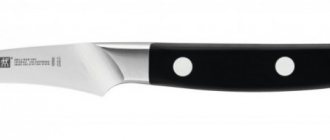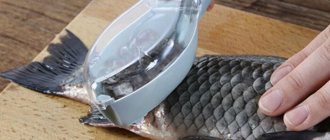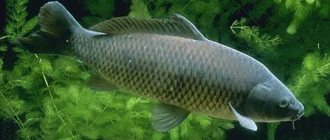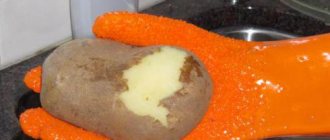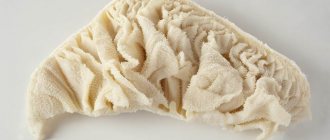Carp is a perishable fish, so cleaning and cutting should be done as soon as possible after catching. The process will require preparation of the premises. In this case, you need to clean up after work much less.
To protect furniture from absorbing fishy smells, you need to prepare a deep, capacious container. Cleaning requires water, and it is better to have it under pressure. It is better to prepare a sponge for washing, and after processing it will have to be thrown away, since the fishy smell will remain in it for a long time.
If you clean carp that is not store-bought, but caught, its mouth should be checked for the presence of remains of gear or bait. Dry fish are much more difficult to clean, so before starting, it is better to soak the carp in water for 15 minutes. The fins should be cut off immediately with scissors, as carp have sharp fins, so there is a risk of cutting yourself. If the scales hold tightly and do not come off the skin well, you can pour boiling water over the carcass.
Beneficial features
Carp is a type of freshwater fish (ray-finned class) and is very popular among fishing enthusiasts. This is a beautiful “resident” of the river depths with dark golden scales. It is characterized by rapid growth. By the age of two, it reaches a length of up to 10 cm. Interesting fact: the word “carp” appeared in Russian from Greek and was translated as “fruit”. By the way, female carp are particularly fertile (one produces up to one and a half million eggs). Carp dishes were especially valued by the rulers of China.
This fish can be classified as a dietary product: 100 grams of fish contains 97 calories. Carp is rich in a large number of vitamins and microelements. The beneficial properties of fish improve overall well-being and strengthen the human immune system. Doctors advise introducing carp into the diet of people suffering from cardiovascular diseases, anemia and liver problems. The meat of this fish is easily digestible, and therefore it is recommended to regularly eat it for children and the elderly.
For all its “usefulness,” carp has one drawback. The fact is that this inhabitant of reservoirs is not particularly picky about food. It eats larvae, worms and mollusks. As a result, harmful compounds can accumulate in his body.
Fish caught in a polluted water body should not be eaten.
Conclusion
Some husbands clean the catch themselves, while their wives only cook it. With us, this mission rests entirely with me: he will bring the fish, put it in a basin for me, looking as if he had killed a mammoth. The breadwinner! And you, wife, let’s clean it, gut it, and prepare delicious dishes. Fresh food for you, they say, a natural product!
And for as long as we’ve been living with him, since we got married in 1999, I’ve been frowning at the fish my husband caught, because he’s a fisherman. Therefore, both in winter and in summer, and at any moment, as soon as the opportunity arises, he rather runs to go fishing, losing his slippers.
I grumble at him, of course, as without this. It used to bring several kilograms of fish, but what should I do? I always say that all husbands are like husbands - they go fishing to drink vodka. What about him? And he catches it.
My husband is a hereditary fisherman. And his father, it turns out, was a fisherman and his grandfather, and his older brother is also a fisherman.
Dear readers, please use my advice with pleasure: how to clean fish from scales easily and quickly without messing up the kitchen - I hope that it was useful to you. Eat fish and be healthy. Surely you also have some housekeeping tips on how to make life easier at home? Please share your experience in the comments.
Cleaning
Cleaning carp at home is not as difficult as it seems at first glance. The process is divided into several stages.
- Cover the kitchen table with thick paper/newspaper. You can use a sink for cutting, but in this case there is a high probability of clogging the drain with remnants of scales and entrails.
- We put on rubber gloves and take the fish carcass. Cut off the fins with kitchen scissors. We press the fish (the head area) and with a scraper (a knife will also work) we remove the scales diagonally, and then from the tail to the head. The process is dynamic and nimble. Try to grab all the scales and pull them “up”. If you couldn’t remove all the scales completely, it’s okay! A small amount of flakes will not harm your health.
- After completely removing the skin with a sharp knife, cut the belly (from the gills to the vertebra) and carefully remove the entrails. When gutting, try not to touch the gall bladder, otherwise the dish will “give off” bitterness. If this mistake could not be avoided, then you need to rub the inside of the carcass with salt and then rinse under running cold water.
- The head of the carp is considered one of its most delicious parts, so in most cases it is not removed, unlike the tail. It is better to remove the gills and eyes of the fish.
Spoon
- Wash the fish and dry with a paper towel.
- Cut two sheets of foil along the length of the carcass. Place the bottom sheet on a baking sheet, add half the salt, and level it out.
- Place carp on top. Sprinkle it with the remaining salt and smooth it out. Cover with the second piece of foil.
- Place in the oven on a medium rack. Cook for 30 minutes at 200 o C. Then cool slightly, carefully free the fish from the salt shell.
When the external processing procedure is completed, butchering the carcass continues the evisceration process. Here it is necessary to remove the gills and internal organs. The peculiarity of freshwater fish is the presence of a gall bladder. It cannot be damaged, so the belly must be cut carefully.
Cutting
Carp is characterized by increased “boning”, so small bones have to be “crushed”. We take a sharp fillet knife and make deep cuts in the skin (from the ridge to the belly) every 3–5 mm on both sides of the previously cleaned and gutted fish. In this way, small bones are crushed and do not cause inconvenience when eating fish. It is not difficult to completely separate the meat from the fish carcass.
- We take a sharp knife and cut the carcass from the gills to the vertebrae.
- Using the tip of a knife, cut the “back” of the fish (up, towards the head).
- We cut off the tail and, using a knife blade, lift the fillet of the fish, separating it from the ribs. We do this first on one side of the carcass, then the same on the other.
- Place the fillet on the board, skin side down, with slits in the middle (do not cut the skin).
- Take a knife and run it along the skin, separating the fillet.
- Leave all leftover fish after cutting for preparing first courses.
Pieces with onions
How to fry carp in a frying pan to get juicy and tasty fish? You will find the answer to this question in our next recipe.
- Carp – 1 pc.
- Onion – 1 pc.
- Flour – 1 tbsp.
- Vegetable oil – 2 tbsp.
- Salt, seasonings - to taste
Cooking time: 20-30 min.
Cooking time: 30-40 min.
Number of servings: 3-4
Calorie content per 100 grams – 189.5; proteins – 6; fats – 0.9; carbohydrates – 39.2.
Cooking method:
- Cut the carp, removing the tail, head and entrails.
- Cut the carp into portions.
- Add salt and leave to marinate for 10-15 minutes.
- Place flour in a deep bowl and add seasoning if necessary.
- Roll each piece of carp in flour.
- Heat a frying pan and add vegetable oil.
- When the oil is hot, place the fish pieces in the pan.
- Fry in a frying pan on one side until golden brown. Turn over and sprinkle onion cut into half rings on top.
- Reduce heat, cover with a lid and bring to readiness.
Spices combined with the aroma of fried onions will give the carp an unusual spicy taste, and stewing under the lid will make the carp steak soft and juicy.
What to cook?
Carp fillet makes surprisingly juicy and tender cutlets. The recipe is so simple that it is suitable even for inexperienced housewives. Required ingredients:
- fish fillet (500–600 grams);
- loaf (several pieces);
- one onion;
- milk (150 ml);
- breadcrumbs:
- vegetable oil;
- salt, pepper, spices to taste;
- greenery;
- one egg.
Soak the loaf in milk. Peel the onion and chop finely, then fry it in vegetable oil. We pass the carp fillet through a meat grinder and add bread to it (squeeze out the milk) and cooled onion. Salt and pepper the minced meat. Add the egg and finely chopped herbs. Mix everything and make small cutlets. Roll in breadcrumbs (or semolina) and place in a hot frying pan. Fry the cutlets on both sides until golden brown. Serve hot with mashed potatoes, rice or boiled pasta. Bon appetit!
To learn how to cook carp, watch the video below.
Cleaning and cutting carp is a simple process, although unpleasant. But after you turn your “fresh catch” into a culinary masterpiece that will delight your family, you will no longer be bothered by the presence of scales, blood and giblets while working on a dish of very healthy and incredibly tasty fish.
Carp baked in mayonnaise – the recipe couldn’t be tastier
If you decide to bake fish for a ceremonial serving, it is better to cook it whole. For a family meal, to make it faster, immediately divide the carp into portions.
- Clean the carp from scales, gut it, rinse, and wipe with napkins.
- Cut the onion into large rings. Cut the tomatoes into slices or circles. Place in a common bowl, season with salt and pepper.
- Lubricate the inside of the fish with mayonnaise and stuff it with a mixture of vegetables.
- Place on a baking sheet, having previously greased it with oil. Spread a generous amount of mayonnaise on top. Sprinkle with paprika. Place some chopped tomatoes and onions around the fish.
- Place the baking sheet in the oven, preheated to 200 o C. Cooking time for carp is an hour.
Features and value of carp
Carp is an artificially bred species of fish, the ancestor of which is the carp. The word "carp" comes from the Greek language and is translated as fruit. And for good reason: one female produces up to 1.5 million eggs. The Chinese were the first to breed domesticated carp. Historians believe that this fish began to be used as food back in 1000 BC. e. Carp dishes became a favorite treat for Chinese emperors. Later, fish began to be bred in other Asian countries and Europe.
Carp meat has great benefits for the body. It is very tender and sweetish in taste. The fat content of fish muscle tissue is lower than that of lean beef, which is important for people on a low-fat diet, as well as for children and athletes. Carp is a source of many important nutrients, proteins and omega-3 fatty acids. These unsaturated acids have a positive effect on cardiac function and help prevent cardiovascular diseases. Another feature of carp is its ease of digestibility, due to the special structure of muscle fibers.
It takes three or four years to grow carp in artificial reservoirs. Three-year-old individuals reach a weight of about 2 kg, and four-year-old individuals weigh more than 2.5 kg.
Carp is a domesticated form of carp
Varieties of carp - gallery
Naked carp have absolutely no scales. The peculiarity of the mirror carp is the arrangement of large shiny scales along the back. The body of the common carp is completely covered with medium-sized scales.
- Fresh carp is easier to clean. If you buy fish in a store or market, try to take it from an aquarium.
You can kill it with a strong blow to the head at a point located slightly above eye level, or simply by cutting off the head (if you are not going to bake the whole carp). There is a more humane way to kill fish - put it in the freezer for an hour and it will fall asleep. - If you do not have the opportunity to buy live fish, it is better to choose fresh chilled fish, since frozen fish loses a large amount of minerals when thawing. When purchasing fresh fish, choose a specimen with the head on. This is the only way you can be sure of its freshness.
- Before buying, look into the eyes of the fish: fresh ones should be bright, slightly moist and convex.
- Be sure to inspect the gills and choose a specimen with clean, bright, and red gills.
- The body of fresh fish is quite elastic, without white coating or dried crusts, and the tail should hang freely from the palm.
- When purchasing frozen carp, pay attention to its glaze. If the fish was properly frozen and stored under all necessary conditions, the glaze on it should be smooth, without cracks. If the carp was frozen using dry freezing, then the carcass should be smooth and hard, without ice.
It is best to thaw frozen fish in water at room temperature. To reduce the loss of minerals during thawing, add table salt to the water (7-10 g per 1 liter of water).
The eyes of fresh fish should be bulging and slightly moist, and the carcass should be elastic, without white coating or dried crusts.
Cleaning and cutting of carp
Currently, a huge number of recipes for cooking carp have been invented. It is baked with a side dish of vegetables, potatoes and cereals, and also boiled with spices, stuffed in various ways and simply fried in vegetable oil until crispy. On store shelves you can find gutted frozen fish, fillets and ready-made semi-finished products. But you'll get the most benefit from fresh or live carp.
Don't be afraid of the upcoming hassle with cutting the fish. Having mastered a few simple rules, you can easily turn live carp into a culinary masterpiece.
The most common carp on sale are common and mirror carp. The latter is a little easier to clean, due to the fact that its scales are large and not very tightly pressed to each other. With common carp you will have to tinker a little longer.
What you need for work
To properly and easily clean and cut fish you will need the following tools:
- sharp knife for cutting fish;
- fish scissors;
- scraper for cleaning fish, you can use a spoon.
To make the process of cleaning and cutting carp easier, purchase the necessary tools: a - sharp knife, b - scissors, c - scrapers
You also need to prepare:
- a plastic bag or bucket for bones and other debris;
- thick paper or newspaper;
- work gloves.
Step-by-step instructions for cleaning, gutting and cutting carp
- Cover the table with thick paper or newspaper.
The paper will absorb the liquid that the fish will release during cutting and prevent contamination of the workplace. Some housewives prefer to clean and cut fish directly in the sink, after closing the drain with a special silicone or metal mesh. Some housewives clean and cut fish in the sink - Wear work gloves.
To prevent the fish from slipping out of your hands, wear work gloves - If you don't need the fins for cooking, cut them off using kitchen scissors. This will help avoid painful punctures while working.
- Press the fish in the area of the head or tail and using a scraper, or if you don’t have one, with a knife or spoon, remove the scales first diagonally from the belly to the back, and only then from the tail to the head. The movements should be short, try to get under the scales, pushing them up.
Don't worry if there are some scales left on the fish. It is, of course, tasteless, but it will not harm your health.Remove scales using a scraper
- To remove the entire skin, from the belly side, cut it around the gills to the vertebral bone, break the bone upward. Carefully remove the giblets from the belly through the incision. Then run the tip of the knife under the skin and begin to remove it with a stocking, using your fingers to separate the skin from the carcass. When you get to the fins, trim them from the inside with sharp scissors. Not reaching 1.5–2 cm from the caudal fin, trim the tail from the inside.
- If skinning is not required, make a shallow cut in the bottom of the carcass near the fin and cut along the belly, stopping at the base of the head.
Remove the entrails, being careful not to crush the gall bladder, otherwise the fish meat will become bitter. If you were unable to keep the gallbladder intact and bile spilled on the carcass, immediately rub it inside with salt, and then rinse with cool water. Cut the carcass along the belly and remove the entrails - Remove the brown film inside the abdomen and, depending on the method of preparing the future dish, remove or leave the head. This part of the carp is considered very tasty, so it should be left.
If you leave the head, then remove the gills and eyes from it.Remove the head or take out the gills
- If you want to get rid of numerous small bones, remove the dorsal fin by pulling it from the tail to the head of the fish.
- Rinse the fish thoroughly with cool running water from the inside and outside.
How to skin a whole carp - gallery
From the side of the abdomen, a transverse incision is made along the head to the vertebral bone. After the incision is made under the skin, you can begin to remove the skin with a stocking. The head of the carp should remain on the skin. To remove the entire skin, the tail and fins of the carp are cut from the inside with a sharp knife
How to fillet fish
When cutting carp into fillets, you need to separate the meat from its inedible parts: skin, spine, bones. To do this, it is not necessary to first gut and scale the fish.
- Using a sharp fillet knife, cut along the gills of the fish to the spine, but do not cut through it.
- Using the sharp part of a knife, make a cut from the dorsal fin side along the vertebrae up towards the head. Guide it until it connects with the original one.
- Use a knife to cut through the fish carcass at the tail end. Having reached the anus, pierce the carcass through and cut off the fillet from the tail.
- From the dorsal fin side, lift the fillet and, trying to avoid the ribs of the fish, separate the meat from them. Use a sharp fillet knife, and then the procedure will not seem tedious.
- When you reach the belly, cut off the top of the fillet. You should end up with two pieces of fish. One piece will be deboned, the other will still need to be processed. Turn the fish over to the other side and remove the fillet from the second part of the fish.
- Place the fillet on a cutting board, skin side down, press down with your hand and cut down the middle to the skin.
Make a cut in the middle of the fish up to the skin to remove it - To remove the fillet, run a knife along the tail and separate it first from one half and then from the other. The same will need to be done with the other half of the carcass.
- All the leftovers after filleting the carp will come in handy when you prepare fish soup. Don't forget to remove the giblets and wash the fish thoroughly under running water.
The art of cutting carp - video
Now you can easily diversify your family’s diet with carp dishes. The described instructions will help you quickly and correctly clean and cut fish that is very tasty and rich in nutrients.
The question of how to clean carp from scales easily and simply worries everyone who likes to eat fish, but does not like to cut it. With the help of our tips, you can easily cope with the task. Even inexperienced housewives can cut and remove fins without unnecessary dirt and waste of time.
Spoon
To properly remove scales, place the carcass on a board and prepare a spoon. You hold it outward with a notch. You need to process with smooth manipulations from the top to the tail of the pike perch against the growth of scales. Pry them onto the fish with the edge of a spoon. The manipulations are similar to how in childhood you dug out parts from the sandbox. This makes it easy to remove the skin from fish weighing 2 kg or more.
When the external processing procedure is completed, butchering the carcass continues the evisceration process. Here it is necessary to remove the gills and internal organs. The peculiarity of freshwater fish is the presence of a gall bladder. It cannot be damaged, so the belly must be cut carefully.
Place the pike perch on a board and hold it by the gill covers with one hand. Using a sharp knife, cut the skin at the base of the head on the ventral side. Insert the tip of the instrument into the cut and move from the top to the bottom, without inserting the knife into the abdomen more than 5 mm.
After opening the abdomen using a convenient method, carefully remove its contents by hand, cut out the intestines and esophagus. Remove the gills. If there is caviar, it can be set aside and used in the diet.
Wash the fish and remove the inner film from the surface of the abdomen. It may contain a bitter aftertaste and ruin the treat. Wash the carcass again and proceed to cutting and cooking.
Features of carp
What kind of carp are you preparing? There are several types of this fish:
- mirror carp;
- Thai;
- Japanese;
- ordinary freshwater.
Delicious fish in salted, smoked, stewed, even boiled form. Use it if you want to enrich the body with iodine, phosphorus, antioxidants, and also improve metabolism, the functioning of brain cells and protect health from cancer. Carp dishes are an excellent option for those who are on a diet.
Choosing a tool for cleaning carp
A variety of tools are used to facilitate the labor of purification. Use a sharp knife or fish scaler. In camping conditions, homemade devices made from glass bottle caps will help - they can be nailed to a wooden base, or an ordinary tin can - make holes from the inside with a nail.
Inexperienced housewives, those who are afraid of cutting themselves, can arm themselves with a spoon or fork - pry up the scales with them and remove them with a digging motion against their growth from the head, gradually moving towards the tail. Buy a vegetable peeler with a longitudinal blade or a special scraper. These are safe and effective tools. If the fish is very large, it is more convenient to cut it in the bathroom. Use scissors to remove fins.
Preparing fresh fish
If you bought carp from an aquarium in a store, ask the sellers to properly cut the live carp. They provide such a service. When you bring home an uncut carcass, it is covered in mucus. It is difficult to hold such an individual in your hands. Rinse it under water - problem solved. Also, the water will soak the scales, making it easier to remove. If you get a large representative, pour boiling water over it. Be sure to cut off the fins before you begin removing the scales. They are sharp and can injure your hands. You are lucky if you choose a mirror carp; it is not completely covered with scales and is easy to clean.
Removing scales
We begin to remove the stratum corneum. Use the tools we talked about earlier. To warn throughout the kitchen, fill a sufficiently sized container with water and carry out the procedure in it. You can protect your kitchen with a regular bag. Place the fish in a bag. Work so that the debris remains inside the cellophane.
Attention!
Dip the carcass in boiling water for no more than one minute; you can quickly clean it.
For adherents of traditional methods, you can simply place the fish on a cutting board and clean off the scales with a knife from the tail to the head; at the end of the work, do not forget to wash the kitchen well.
How to clean a carcass from scales using the “removal of chain mail” method
Prepare a sharp butcher (with a long blade). Use it to pry the scales at the base of the tail, but do not damage the skin. Cut off the scales by moving the tool towards the head. In the place near the head where the scales are connected to the bone, make a cut - this is how you get chain mail. Do the same on the other side.
How to gut a carcass
The next step is to cut it correctly. Make an incision in the belly and carefully remove the contents. Do not damage the gallbladder, otherwise the meat will become bitter. The abdominal cavity is covered with a dark film - you need to clear the pulp from it. Now you can cut off the head and wash the carp. The fish is now ready for filleting. Cut the meat along the spine, but do not damage the ribs. Place the knife under the ribs and separate the pulp. Cut the fillet from the tail.
How to cut fins
It’s not difficult to cut off the fins without getting pricked by them. You need to make a couple of cuts on the sides and cut out the fin. Pull out the ones on the sides with your fingers. To remove the lower ones, you will need long cuts on both sides. Start cleaning while the fish is fresh. Frozen carp are difficult to clean.
Some tips will help inexperienced housewives prepare fish correctly and not spoil the dish. In cooking, sometimes little things can significantly affect the taste of a dish. If you cook whole, remove the gills and eyes. Do the same if you are going to cook fish soup from heads and tails. Place the remaining fish in cold water - this will make the broth richer, and put the valuable meat at the end of cooking, then it will retain its beneficial properties.
Carp is a tasty, moderately fatty freshwater fish. You can prepare various dishes from it; fish pie is especially tasty. Due to the fact that the scales of this fish fit very tightly to the body, not every housewife knows how to clean carp correctly. Because of this, the kitchen area often requires a thorough cleaning after cutting carp. But knowing some secrets you can avoid such consequences. It must be cleaned fresh and in three stages: preparation, removal of scales, removal of entrails.
How to quickly clean fish from scales both at home and outdoors
These methods are good for cleaning purchased fish, but if you were in nature and caught fish yourself in rivers, what should you do, what is the best way to clean it?
1. You will need a small and sharp knife, as well as a piece of wood. To prevent the fish from jumping up and trying to escape, you need to hit it on the head several times before cleaning (no matter how cruel it sounds).
Then, placing the fish on the board and holding the head with one hand, begin the cleaning process from the tail, moving towards the head. Your knife should clean the fish from scales in the opposite direction of scale growth, so to speak, “against the grain.”
Particular care should be taken to clean around the fins, on the belly and near the head. After cleaning one side, turn it over and repeat the same procedure on the other side.
After external cleaning of scales, we proceed to cleaning of internal organs. Using a knife from the tail to the head, cut the belly (belly) of the fish and remove all the entrails. After this, we wash the already cleaned fish in water, paying special attention to washing where we removed the insides of the fish.
If the fish is large (carp, carp, grass carp), then you still need to remove the gills.
2. The second cleaning method differs from the first, only with the cleaning tool. Take a small board about 10-12cm long, 3-4cm wide, and at least two centimeters thick.
Next, you should nail three glass beer bottle caps. They must be nailed along the length of the board in a row, with the flat of the lid to the surface of your workpiece, so that the sharp edges of the lid protrude outward.
With this tool you make the same movements as with a knife, starting from the tail and moving towards the head of the fish. I can say with confidence that the process of cleaning fish with such a unique tool will be much faster than with a knife.
And also offer a recipe, very tasty.
Carp, or common carp, is the most common fish in many rivers of the country. You can buy it at the market or catch it yourself in a pond. If you catch a large carp, it is advisable to immediately clean it of scales in nature. Everyone knows that the scales of these fish are large and dense; when cleaned, they can scatter in different directions, clogging both the kitchen sink and part of the wall near the washbasin.
Some housewives at markets pay money to traders for cleaning fish, so as not to face the problem of dirt in the kitchen, not to mention the unpleasant smell and mucus that remains on their hands and knives.
In this article we will tell you how to clean carp at home. Let us explain the rules for cleaning common carp from scales and entrails before preparing fish dishes. Let's look at what tools you can use to make your work easier.
Preparing fresh fish
Carp lives in fresh water bodies; most often this fish ends up on the table from a store or as a fisherman’s catch. If it was caught with bait, then the latter needs to be removed from the throat; this can be done by directing a stream of water there, which will wash away all the excess. You also need to remove the gills from the head, where bacteria begin to multiply first. All this is necessary if the preparation requires the presence of a head, otherwise it can simply be cut off later.
The carcass must be thoroughly washed to remove silt and the slimy coating that protects the scales. To do this, simply rinse the carp under running water. It is also worth cutting off the fins first so that they do not interfere when the time comes to clean the carp from scales. They can easily hurt you.
Appearance
- Thick body of moderate length.
- Large, uniform, cylindrical scales with a characteristic edging on the sides.
- The sides are brown or golden yellow.
- Double nostrils.
- He often pulls his mouth into a tube.
- Small mustache above the upper lip.
- The eyes are set high, the pupils are small.
- Dark back with characteristic gray-olive fins.
- In adult specimens, brownish, gray and dark gray tones predominate in the general color.
- There are individuals that have no scales. This variety is called naked carp.
Carp is a freshwater fish; it comes to the table either from the store or by catching it yourself from a reservoir. It can grow up to one and a half meters. This fish lives in rivers and lakes, and is found in ponds, reservoirs, and artificial reservoirs. It is almost impossible to find it in the ocean and in the sea. This is due to the fact that it is not able to live in salt water.
Removing scales
At this stage, it is most difficult to clean carp, so you must know how to properly remove scales from the fish. It is best to use a special fish cleaning device for this. They have sharp serrations that easily separate even the toughest scales. Such devices are sold in stores or can be made independently.
During cleaning, the scales fly in different directions. To avoid this, housewives recommend cleaning in a basin of water so that the scales remain in it. Either place the fish inside the bag and put your hands in there to clean it inside, so all the cleaning will remain there.
Advice! To more easily and effortlessly separate the scales from the fish, it must be placed in boiling water. The time required to achieve the desired effect is no more than 1 minute, otherwise the carp will be cooked.
Scales from large fresh carp can be removed with a knife. To do this, place the fish on a cutting board and, pressing down on the tail, clean the carcass with sharp movements. But it is in this case that the housewife finds herself in a situation where, after she has cleaned the carp, she needs to clean out the kitchen. Therefore, the above measures should be taken.
Working at home
If you love fish dishes and often have to clean fish, then buy a special scraper with a closing lid. All scales will fall into a plastic container, and the kitchen will remain clean.
Cleaning the scales is carried out according to the method described above from the tail to the head. Here are some useful tips to help you complete the task easier:
- Only freshly caught fish can be cleaned well, so if you are on the river bank, clean it right away.
- To quickly cut up carp, use either fish scalers or sharply sharpened knives.
- Place a cutting board under the carcass.
- For ease of cleaning in nature, experts recommend inserting a wooden stick into the fish’s mouth.
- To prevent it from slipping out of your hands, you can secure the tail to the board with a rope or elastic band.
- If you clean the fish and hold the tail in your hands, then use a regular paper napkin so that it does not slip out.
- You can use a pinch of coarse salt instead of a napkin, but first check that there are no abrasions or wounds on your hands, otherwise it will sting.
You already understand how to clean carp. If you are unable to get rid of the fishy smell on your hands, use lemon juice. You can simply rub a piece of lemon on your fingers and there will be no smell.
We cut the carcass
Having ensured that both sides of the carcass are thoroughly cleaned, you can begin cutting it up. To do this, you need to put it on a cutting board and cut into the abdominal cavity. From there, you should carefully remove the entrails so as not to damage the gall bladder, otherwise it will ruin the taste of the meat.
And it is also important to remove the dark film that covers the abdominal cavity from the inside. Cut off the head. After this, the fish must be thoroughly rinsed under running water. If the dish requires it, you can separate the fillet from the bone. To do this, you need to make cuts parallel to the spine, reaching the ribs without damaging them. Then run a knife under the ribs to remove the flesh from them. After this, cut the fillet from the tail section.
Now this process will not cause any difficulties for anyone. And everyone can enjoy this delicious lake fish.

